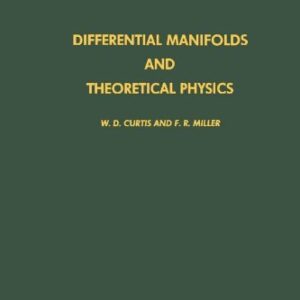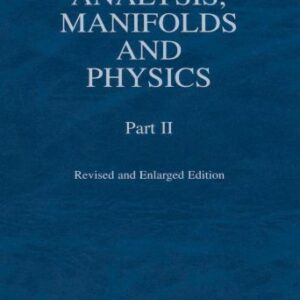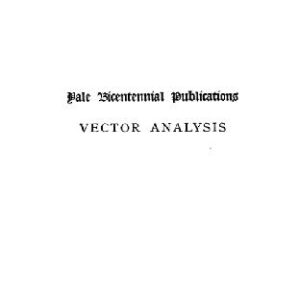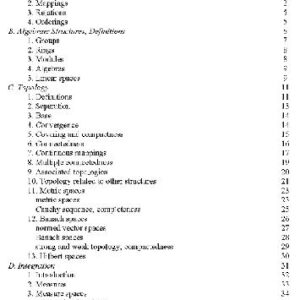Very didactical textbook
Presents the mathematical basics for each topic
Contains many exercises and solutions for teaching and learning
This textbook presents a basic course in physics to teach mechanics, mechanical properties of matter, thermal properties of matter, elementary thermodynamics, electrodynamics, electricity, magnetism, light and optics and sound. It includes simple mathematical approaches to each physical principle, and all examples and exercises are selected carefully to reinforce each chapter. In addition, answers to all exercises are included that should ultimately help solidify the concepts in the minds of the students and increase their confidence in the subject. Many boxed features are used to separate the examples from the text and to highlight some important physical outcomes and rules. The appendices are chosen in such a way that all basic simple conversion factors, basic rules and formulas, basic rules of differentiation and integration can be viewed quickly, helping student to understand the elementary mathematical steps used for solving the examples and exercises.
Instructors teaching form this textbook will be able to gain online access to the solutions manual which provides step-by-step solutions to all exercises contained in the book. The solutions manual also contains many tips, colored illustrations, and explanations on how the solutions were derived.
Content Level ? Lower undergraduate
Keywords ? electricity – fluid- and aerodynamics – light waves – magnetism – mechanical properties of matter – mechanics – optics – oscillations and waves – physics, general – sound – sound waves – thermal properties of matter – thermodynamics
Related subjects ? Classical Continuum Physics – Electronics & Electrical Engineering – Materials – Mechanical Engineering – Optics & Lasers
Cover
Undergraduate Lecture Notes in Physics
Principles of Physics For Scientists and Engineers
Copyright
Springer-Verlag Berlin Heidelberg 2013
ISSN 2192-4791
ISSN 2192-4805 (electronic)
ISBN 978-3-642-23025-7
ISBN 978-3-642-23026-4 (eBook)
DOI 10.1007/978-3-642-23026-4
Preface
Acknowledgments from Prof. Hafez A. Radi
Acknowledgments from Prof. John O. Rasmussen
Contents
Preface
Fundamental Physical Constants
Other useful constants
The greek alphabet
Some SI base units and derived units
SI multipliers
Part I Fundamental Basics
1 Dimensions and Units
1.1 The International System of Units 3
1.2 Standards of Length, Time, and Mass 5
1.3 Dimensional Analysis 9
1.4 Exercises 12
2 Vectors
2.1 Vectors and Scalars 17
2.2 Properties of Vectors. 19
2.3 Vector Components and Unit Vectors 22
2.4 Multiplying Vectors 27
2.5 Exercises 33
Part II Mechanics
3 Motion in One Dimension
3.1 Position and Displacement 41
3.2 Average Velocity and Average Speed 42
3.3 Instantaneous Velocity and Speed 44
3.4 Acceleration 48
3.5 Constant Acceleration 52
3.6 Free Fall 57
3.7 Exercises 62
4 Motion in Two Dimensions
4.1 Position, Displacement, Velocity, and Acceleration Vectors 71
4.2 Projectile Motion 79
4.3 Uniform Circular Motion 87
4.4 Tangential and Radial Acceleration. 90
4.5 Non-uniform Circular Motion. 91
4.6 Exercises 93
5 Force and Motion
5.1 The Cause of Acceleration and Newton?s Laws 103
5.2 Some Particular Forces 106
5.3 Applications to Newton?s Laws 113
5.4 Exercises 124
6 Work, Energy, and Power
6.1 Work Done by a Constant Force 137
6.2 Work Done by a Variable Force. 142
6.3 Work-Energy Theorem 148
6.4 Conservative Forces and Potential Energy 151
6.5 Conservation of Mechanical Energy 157
6.6 Work Done by Non-conservative Forces 159
6.7 Conservation of Energy 162
6.8 Power 166
6.9 Exercises 170
7 Linear Momentum, Collisions, and Center of Mass
7.1 Linear Momentum and Impulse 181
7.2 Conservation of Linear Momentum. 184
7.3 Conservation of Momentum and Energy in Collisions 187
7.4 Center of Mass (CM) 195
7.5 Dynamics of the Center of Mass 199
7.6 Systems of Variable Mass 203
7.7 Exercises 209
8 Rotational Motion
8.1 Radian Measures 227
8.2 Rotational Kinematics; Angular Quantities 228
8.3 Constant Angular Acceleration 232
8.4 Angular Vectors 233
8.5 Relating Angular and Linear Quantities 233
8.6 Rotational Dynamics; Torque 238
8.7 Newton?s Second Law for Rotation 240
8.8 Kinetic Energy, Work, and Power in Rotation 248
8.9 Rolling Motion 252
8.10 Exercises 259
9 Angular Momentum
9.1 Angular Momentum of Rotating Systems 269
9.2 Conservation of Angular Momentum 277
9.3 The Spinning Top and Gyroscope 285
9.4 Exercises 289
10 Mechanical Properties of Matter.
10.1 Density and Relative Density 304
10.2 Elastic Properties of Solids 306
10.3 Fluids 314
10.4 Fluid Statics 316
10.5 Fluid Dynamics 328
10.6 Exercises 345
Part III Introductory Thermodynamics
11 Thermal Properties of Matter.
11.1 Temperature 357
11.2 Thermal Expansion of Solids and Liquids 360
11.3 The Ideal Gas 365
11.4 Exercises 371
12 Heat and the First Law of Thermodynamics
12.1 Heat and Thermal Energy 379
12.2 Heat and Work. 390
12.3 The First Law of Thermodynamics 395
12.4 Applications of the First Law of Thermodynamics 396
12.5 Heat Transfer 406
12.6 Exercises 416
13 Kinetic Theory of Gases
13.1 Microscopic Model of an Ideal Gas 427
13.2 Molar Specific Heat Capacity of an Ideal Gas 434
13.3 Distribution of Molecular Speeds 441
13.4 Non-ideal Gases and Phases of Matter 442
13.5 Exercises 444
Part IV Sound and Light Waves
14 Oscillations and Wave Motion
14.1 Simple Harmonic Motion 451
14.2 Damped Simple Harmonic Motion 462
14.3 Sinusoidal Waves 463
14.4 The Speed of Waves on Strings 470
14.5 Energy Transfer by Sinusoidal Waves on Strings 472
14.6 The Linear Wave Equation 476
14.7 Standing Waves 477
14.8 Exercises 486
15 Sound Waves
15.1 Speed of Sound Waves 499
15.2 Periodic Sound Waves 502
15.3 Energy, Power, and Intensity of Sound Waves 505
15.4 The Decibel Scale 510
15.5 Hearing Response to Intensity and Frequency 514
15.6 The Doppler Effect 514
15.7 Supersonic Speeds and Shock Waves 521
15.8 Exercises 523
16 Superposition of Sound Waves
16.1 Superposition and Interference 531
16.2 Spatial Interference of Sound Waves 533
16.3 Standing Sound Waves 537
16.4 Standing Sound Waves in Air Columns 541
16.5 Temporal Interference of Sound Waves: Beats 549
16.6 Exercises 554
17 Light Waves and Optics
17.1 Light Rays 561
17.2 Reflection and Refraction of Light 563
17.3 Total Internal Reflection and Optical Fibers. 568
17.4 Chromatic Dispersion and Prisms 571
17.5 Formation of Images by Reflection 575
17.6 Formation of Images by Refraction. 583
17.7 Exercises 595
18 Interference, Diffraction and Polarization of Light
18.1 Interference of Light Waves 603
18.2 Young?s Double Slit Experiment 604
18.3 Thin Films-Change of Phase Due to Reflection 611
18.4 Diffraction of Light Waves 615
18.5 Diffraction Gratings 620
18.6 Polarization of Light Waves 624
18.7 Exercises 627
Part V Electricity
19 Electric Force
19.1 Electric Charge. 637
19.2 Charging Conductors and Insulators 639
19.3 Coulomb?s Law 642
19.4 Exercises 651
20 Electric Fields
20.1 The Electric Field 659
20.2 The Electric Field of a Point Charge 660
20.3 The Electric Field of an Electric Dipole 666
20.4 Electric Field of a Continuous Charge Distribution 670
20.5 Electric Field Lines 684
20.6 Motion of Charged Particles in a Uniform Electric Field 686
20.7 Exercises 691
21 Gauss?s Law
21.1 Electric Flux 701
21.2 Gauss?s Law 705
21.3 Applications of Gauss?s Law 707
21.4 Conductors in Electrostatic Equilibrium 717
21.5 Exercises 720
22 Electric Potential
22.1 Electric Potential Energy 731
22.2 Electric Potential 733
22.3 Electric Potential in a Uniform Electric Field 735
22.4 Electric Potential Due to a Point Charge 741
22.5 Electric Potential Due to a Dipole 745
22.6 Electric Dipole in an External Electric Field 747
22.7 Electric Potential Due to a Charged Rod 749
22.8 Electric Potential Due to a Uniformly Charged Arc 752
22.9 Electric Potential Due to a Uniformly Charged Ring. 753
22.10 Electric Potential Due to a Uniformly Charged Disk. 754
22.11 Electric Potential Due to a Uniformly Charged Sphere 756
22.12 Electric Potential Due to a Charged Conductor 757
22.13 Potential Gradient 758
22.14 The Electrostatic Precipitator 761
22.15 The Van de Graaff Generator. 762
22.16 Exercises 763
23 Capacitors and Capacitance
23.1 Capacitor and Capacitance 773
23.2 Calculating Capacitance. 775
23.3 Capacitors with Dielectrics 781
23.4 Capacitors in Parallel and Series. 790
23.5 Energy Stored in a Charged Capacitor. 795
23.6 Exercises 797
24 Electric Circuits
24.1 Electric Current and Electric Current Density 809
24.2 Ohm?s Law and Electric Resistance 814
24.3 Electric Power 823
24.4 Electromotive Force 825
24.5 Resistors in Series and Parallel 829
24.6 Kirchhoff?s Rules 834
24.7 The RC Circuit 838
24.8 Exercises 844
Part VI Magnetism
25 Magnetic Fields
25.1 Magnetic Force on a Moving Charge 859
25.2 Motion of a Charged Particle in a Uniform Magnetic Field 863
25.3 Charged Particles in an Electric and Magnetic Fields 865
25.4 Magnetic Force on a Current-Carrying Conductor. 869
25.5 Torque on a Current Loop 874
25.6 Non-Uniform Magnetic Fields 878
25.7 Exercises 879
26 Sources of Magnetic Field
26.1 The Biot-Savart Law. 889
26.2 The Magnetic Force Between Two Parallel Currents. 895
26.3 Ampere?s Law 897
26.4 Displacement Current and the Ampere-Maxwell Law 901
26.5 Gauss?s Law for Magnetism 903
26.6 The Origin of Magnetism 904
26.7 Magnetic Materials 908
26.8 Diamagnetism and Paramagnetism 910
26.9 Ferromagnetism 914
26.10 Some Applications of Magnetism 919
26.11 Exercises 921
27 Faraday?s Law, Alternating Current, and Maxwell?s Equations
27.1 Faraday?s Law of Induction 933
27.2 Motional emf 936
27.3 Electric Generators 940
27.4 Alternating Current 942
27.5 Transformers 943
27.6 Induced Electric Fields 945
27.7 Maxwell?s Equations of Electromagnetism 947
27.8 Exercises 950
28 Inductance, Oscillating Circuits, and AC Circuits
28.1 Self-Inductance. 961
28.2 Mutual Inductance 964
28.3 Energy Stored in an Inductor 966
28.4 The L-R Circuit 967
28.5 The Oscillating L-C Circuit 971
28.6 The L-R-C Circuit 974
28.7 Circuits with an ac Source 977
28.8 L-R-C Series in an ac Circuit 984
28.9 Resonance in L-R-C Series Circuit 988
28.10 Exercises 988
Appendix A Conversion Factors 999
Appendix B Basic Rules and Formulas 1003
Appendix C The Periodic Table of Elements 1013
Answers to All Exercises
Index

![[pdf] Principles of physics. For Scientists and Engineers Hafez A. Radi, John O. Rasmussen](https://pdfelite.com/wp-content/uploads/2024/04/003e95c1c23e5fb7a384d872c3870ba1-g.jpg)




Reviews
There are no reviews yet.